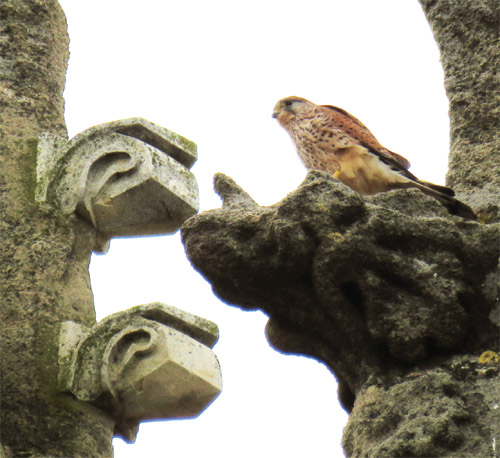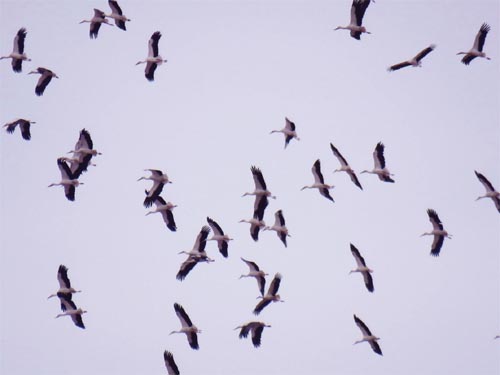| Our
only break outside the country last year was a long weekend
in Seville in late November. I’d been there briefly many
years ago at the last night of an organised birdwatching trip
and had always hoped to go back again to see more of the beautiful
city. The previous trip had been to visit the Cota Donana National
Park, the vast estuary at the mouth of the Guadalquivir River
which provides an internationally important breeding and wintering
ground for hundreds of thousands of birds. On that trip we’d
seen a wondrous array of birds in wetland, scrublands and other
habitats. Every vista had Black Kites or Vultures drifting across
the sky in the background and it’s where I got my first
ever views of many bird species including Avocet, Black winged
Stilt, Squacco Heron, Purple Heron, Night Heron, Flamingo, Spoonbill,
a colony of Collared Pratincole, Fan Tailed Warbler and, resembling
a very colourful Moorhen, the Purple Gallinule. Highlights for
me included the beautiful Great Spotted Cuckoo, from the same
order of birds as our own cuckoo but when this species lays
an egg in a host bird’s nest, often the nest of a magpie
or carrion crow, the hatchling doesn’t evict the host
bird’s chicks or eggs but is fed alongside them and can
even provide them with protection against potential predators
by secreting a repellent scent.
Another relative of one of our native, but
not well regarded birds, is the very handsome Azure-winged Magpie.
This species is very significant for having two populations
that exist
separated by thousands of miles, this one in Spain and Portugal
and the other in China and the East Asian seaboard. It’s
believed the populations became separated during the ice age
over one million years ago. The azure-winged magpies were very
obliging to visitors as well since they frequented the picnic
tables near a park cafe where inside swallows flew above the
heads of the diners to their nests in the roof beams.
Some
of the cafe’s windows had horizontal bars rather than
glass, enabling the birds to fly in at all hours of the day
or evening which I thought was a charming concession to them. |
|

Kestrel Perched on Seville Cathedral
Photo Michael Ryan |

A
Mustering of White Storks over Seville Photo Michael
Ryan |
|
Another highlight for me was of a bird known
in, very unflattering, birding parlance as a typical LBJ or
Little Brown Job. Although unspectacular in appearance, the
Nightingale is justifiably famous for its beautiful song which
is usually delivered from dense undergrowth but this particular
individual we saw was perched very near on a bare branch giving
us wonderful views head tilted upwards as he poured out his
song. That first trip was in early spring, the peak of the breeding
and nesting season before the heat got too unbearable lthough
the midday heat added to the atmosphere when we visited the
town of El Rocio which could easily have featured in a Spaghetti
Western with its broad sandy streets and sun baked buildings,
many with hitching posts outside them. To add to the impression
a solitary figure trotted his horse through the almost deserted
town while Griffon Vultures soared in the skies above.
Anyhow on our recent trip we didn’t
expect to see much wildlife, being confined to the city of Seville
in winter far away from the wildfowl’s wintering grounds.
One bird we did see a lot of was the Rose-ringed parakeets,
a very loud and vivid presence in Seville as they are now in
many European cities where populations, deriving from released
or escaped captive birds, have done phenomenally well. Their
presence and monopoly of nesting sites have long been thought
to be detrimental to native species and in Seville they have
been proven to have a very harmful effect on the small, already
vulnerable population of Greater Noctule Bats which nest in
the trees of Maria Luisa Park. Researchers studying the bats
started finding their corpses badly savaged with holes torn
in their wings with pregnant bats seeming particularly vulnerable.
The researchers subsequently observed the parakeets attacking
them presumably to eject them from potential nest sites. |
Although
a summer migrant from Africa a small percent are known to overwinter
in Spain and I thought this was one of them but subsequent examination
of the photo led me to realise I’d been fooling myself
and it was in fact a female Common Kestrel, the same as our
own native species. On our previous trip to Seville we’d
seen small flocks of birds darting above the narrow streets
around the cathedral at dusk hawking for insects. Their long
pointed wings made us suspect then they might be Nightjars but
subsequently we realised they were almost certainly Lesser Kestrels
which are now known to hunt at night by artificial light. There’s
a wonderful wooden structure, the Metrop Parasol, towering over
one street incentral Seville and the walkways on the roof give
great views over the city.
From there Lucy spotted a dark swirling mass
of birds over distant rooftops. Initially I thought they were
probably gulls but as they approached I was able to zoom in
on them with the camera and saw they were White Storks, dozens,
maybe even hundreds, of them moving across the sky in a huge
flock. Previously in Spain white storks always used
to migrate, heading to Africa at the end of summer but in recent
decades large numbers of them have begun to overwinter, feeding
on rubbish tips and reducing the risks involved in migrating
across the Mediterranean where many birds fall prey to hunters
while more are killed in collisions with power lines. Cutting
out the risks involved in a long migration has resulted in a
healthy increase of the stork’s population and we were
delighted to see the evidence flying in front of us.
|
|